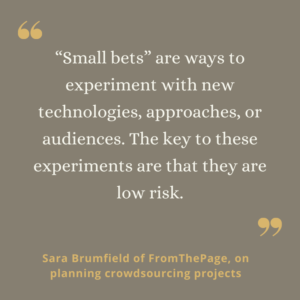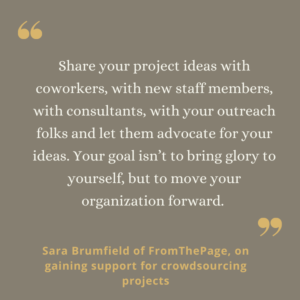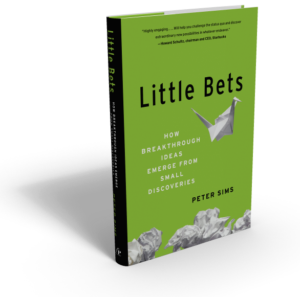 “Small bets” are ways to experiment with new technologies, approaches, or audiences. The key to these experiments are that they are low risk. If it doesn’t work out, then you haven’t lost that much money or time or goodwill. If it does work out, then you have a new way of engaging the public, enriching your metadata, and increasing use of your material. Most importantly, in either case you’ve learned things. What to do. What not to do. What skills you may need to work on to be more successful. The value the project brought to your organization so you can make a stronger pitch for another project -- or an ongoing crowdsourcing program.
“Small bets” are ways to experiment with new technologies, approaches, or audiences. The key to these experiments are that they are low risk. If it doesn’t work out, then you haven’t lost that much money or time or goodwill. If it does work out, then you have a new way of engaging the public, enriching your metadata, and increasing use of your material. Most importantly, in either case you’ve learned things. What to do. What not to do. What skills you may need to work on to be more successful. The value the project brought to your organization so you can make a stronger pitch for another project -- or an ongoing crowdsourcing program.
I learned about this approach from Peter Sims' book Little Bets, which uses examples from the business world, but works for introducing innovation into any sort of organization.
 Small bets -- in the form of a project -- are also great ways to sell your dreams of crowdsourcing success to your management. Be they library deans or nonprofit boards, if you walk in and say: “I’d like to experiment with crowdsourcing. It will cost us $3000 (or less, depending on the size of the project or how long it takes), run for a year, transcribe this exact collection of high value/high interest materials (or materials that support our organization’s goal of <fill in their goal here>), and take up 2 hours a week of my time. Monthly I’ll be able to tell you how many folks we engaged with, how many pages were transcribed, what we discovered in the archives. By the end of the year we’ll know if this is something we have the skills to do, if it helps us meet our goals, and if it’s worth the time and money it costs.
Small bets -- in the form of a project -- are also great ways to sell your dreams of crowdsourcing success to your management. Be they library deans or nonprofit boards, if you walk in and say: “I’d like to experiment with crowdsourcing. It will cost us $3000 (or less, depending on the size of the project or how long it takes), run for a year, transcribe this exact collection of high value/high interest materials (or materials that support our organization’s goal of <fill in their goal here>), and take up 2 hours a week of my time. Monthly I’ll be able to tell you how many folks we engaged with, how many pages were transcribed, what we discovered in the archives. By the end of the year we’ll know if this is something we have the skills to do, if it helps us meet our goals, and if it’s worth the time and money it costs.
Good managers are looking for innovation. They want to do crazy new things, but they are scared of the risk involved. What if it makes our institution look bad? What if there are runaway costs? What if our project is full of spam? (don’t worry -- we handle this for you -- but they don’t know that!) How you get their buy-in is by answering as many of their objections as possible and reducing that risk.
Here’s your steps:
- Look at your organization’s goals and focus for the year. Is there a historical event or anniversary you are celebrating? Are you responding to a social movement? What exhibits will be shown this year? What of your material is being loaned out for some other organization’s exhibits? What pressures is the organization feeling? What are peer institutions doing? The Alabama Department of Archives and History’s first project was transcribing WWI Service Cards was tied to the centennial of WWI, Sewanee’s projects were for their Race & Reconciliation Commission. Corpus Christi College at the University of Cambridge created a project that tied in with a loan of eleven manuscripts they made to the British Library for their exhibition, Anglo-Saxon Kingdoms: Art, Word, War.
- Find material in your collection that supports that focus or goal. Maybe it’s your Black student organization records or letters from the founding of your institution or minutes from the building of certain buildings. Maybe it’s material that ties to an upcoming exhibit. The material can be hand written or typewritten, long form like letters, diaries, or field books; field based like marriage records or draft cards or scientific observations, or ledgers like tax rolls, voting rolls, financial or scientific records.
- Make a plan. What would be interesting to do with that material? What information is useful and serves a purpose to a researcher, the public, or your institution? Would you transcribe it? Describe it? Index it?
- Assess digitization status. Is the material digitized? If not, what is your plan to digitize it? How much time and money will that cost?
- Find your crowd. Who would you engage on your project? The public? Alumni? Subject matter enthusiasts? Family historians? Historians? Staff? Student workers?
- Make a timeline. You may have specific dates in mind, but you can also just do “month 1”, “month 2”. Specific tasks you might want to include: “upload documents”, “develop transcription conventions by having staff transcribe 5 pages”, “develop an outreach plan”, “host a transcribathon to kick off the project”, “respond to inquiries, questions, etc. daily for 15 minutes”, “test export and reingest”, “add second set of materials”, “write a newsletter monthly”, “celebrate with volunteers.”
- Evaluate the budget. Include the cost of FromThePage, digitization, any events like a transcribathon or celebration or symposium.
- Turn the above into a set of slides. I’d suggest around 5 slides, with lots of bullets. Your goal is not to be comprehensive, but to sell your idea. You’ve done your due diligence, you can answer questions to show that, and you can refer people to the full project documentation you developed in steps 1-7 once you’ve sold them on both the idea and your ability to run with it. Present to your direct management, but then be prepared to present or help them present the same idea -- hopefully with additions they’ve enthusiastically added -- to their management. Repeat until you get either management’s blessing and funding or a “no.”
 If you get a “no,” ask “What could make this a feasible project in the future?” If the answer is “funding” you may want to look for grant funds or see if donors of materials would be interested in funding a project using their materials. If the answer is “this is scary” -- of course, they won’t say that; you’ll have to infer it -- every month or two forward them a thoughtful example of another institution’s crowdsourcing project or one of our newsletters or a conference session with a very mild “I thought you might find this interesting.” Share your project ideas with coworkers, with new staff members, with consultants, with your outreach folks and let them advocate for your ideas. Your goal isn’t to bring glory to yourself, but to move your organization forward. If you’re an enthusiastic, positive, relentless advocate for your idea, eventually the organization, the make-up of the organization, or your place in (or outside!) of it will change and you’ll get your chance.
If you get a “no,” ask “What could make this a feasible project in the future?” If the answer is “funding” you may want to look for grant funds or see if donors of materials would be interested in funding a project using their materials. If the answer is “this is scary” -- of course, they won’t say that; you’ll have to infer it -- every month or two forward them a thoughtful example of another institution’s crowdsourcing project or one of our newsletters or a conference session with a very mild “I thought you might find this interesting.” Share your project ideas with coworkers, with new staff members, with consultants, with your outreach folks and let them advocate for your ideas. Your goal isn’t to bring glory to yourself, but to move your organization forward. If you’re an enthusiastic, positive, relentless advocate for your idea, eventually the organization, the make-up of the organization, or your place in (or outside!) of it will change and you’ll get your chance.

